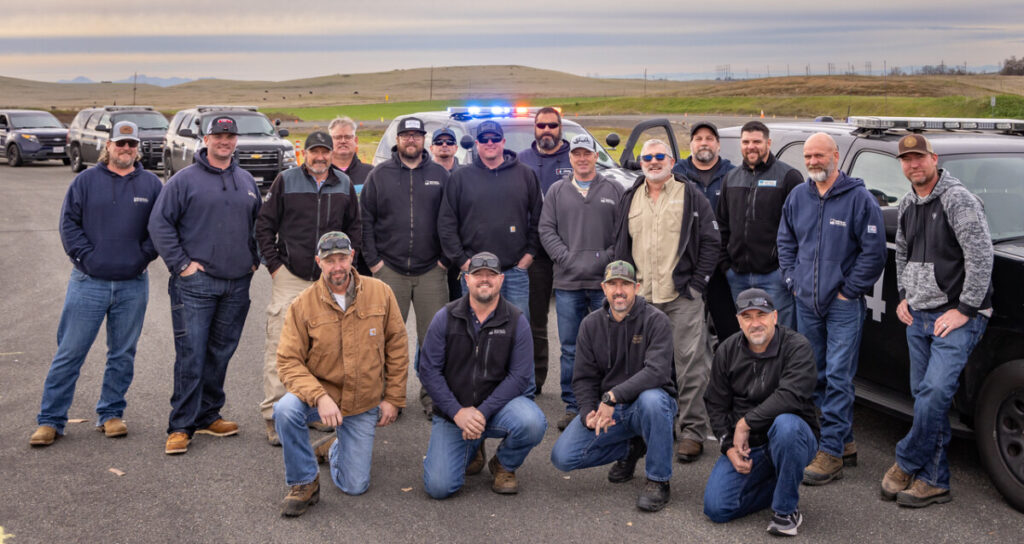
IBEW 1245 members from PG&E at the Emergency Vehicle Operator Course in Oroville, CA.
Statistically, the most hazardous thing that IBEW 1245 members do every day isn’t working around energized power lines or gas mains; it’s getting behind the wheel of a vehicle. Some 1245 members drive hundreds of miles per day across the service territory, where they regularly encounter ever-changing conditions, unexpected hazards and challenging off-road terrain.
As utility first responders, understanding and practicing safe driving techniques is a critical skill, not just for 1245 members’ own safety, but also for the safety of others on and around the road.
To better prepare for any potential hazards they may come across while driving, IBEW 1245 members at PG&E now have the opportunity to participate in the Emergency Vehicle Operator Course (EVOC), administered by the State of California’s Commission on Peace Officer Standards and Training (POST) in collaboration with the state college system.
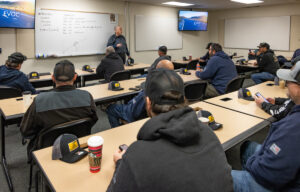
The EVOC training begins with a classroom lesson and test before the participants get behind the wheel.
The training, designed for police officers, firefighters, EMTs, park rangers and other emergency responders, provides skills and knowledge, as well as practical simulations, to ensure that emergency response drivers are prepared to handle their vehicles safely in any situation that may arise. The day-long training includes a classroom lesson and a written test, followed by hands-on practice behind the wheel in a controlled training environment.
***
The Utility Reporter caught up with a group of IBEW 1245 linemen from PG&E at a recent EVOC training in Oroville, CA.
IBEW 1245 member and PG&E Compliance Inspector Chad Oliver explained what he hoped to gain from the session.
“I want to get a little more experience with high-speed slides and understeer and oversteer — especially in the snow, in the mud, in the gravel and the off-road conditions we face daily,” said Oliver. “In our department, we are mostly we are driving Ford F550 single bucket trucks. And those are a lot more challenging than these [vehicles used for the training simulation]. They steer a lot better, but they also have a whole lot of top weight.”
The EVOC training took place at Butte Community College. After an eye-opening lesson in the classroom, the participants headed out to the large, sprawling swath of land behind the campus, which presents an optimal environment to facilitate simulations that mimic dangerous road conditions. EVOC uses unique tools that allow participants to practice safe driving techniques in a controlled environment. Course Instructor Gary Scholar explained one such simulation program.
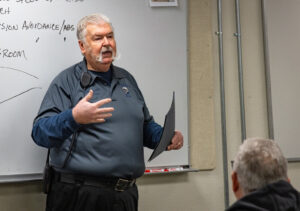
VOC Instructor Gary Scholar
“We have the ability of using a large flat surface — we call it the skid pan — and we have cars that are designed to lose traction. So we can simulate, at 12 or 15 miles an hour, what a vehicle feels like at 70 or 80 mph,” said Scholar, explaining how this approach keeps the training participants safe while allowing them to experience the feel of a true-to-life highway driving scenario. “Even though we’re going slow [during the simulation], the feeling that you get, the muscle memory that you develop here, it comes into play in real-life driving.”
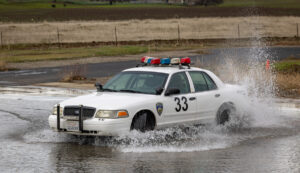
The “skid pan” is a training tool to allow drivers to learn how to maintain control of the vehicle.
The session also included hands-on training in obstacle avoidance.
“We’re trying to simulate something like a vehicle coming in front of them, or a kid on a bike, or something fell out of a truck,” Scholar explained. “They get to practice emergency evasive maneuvers, so they learn how to get around that obstacle without losing control of the vehicle.”
For IBEW members, having a safe, controlled environment to practice the most hazardous parts of the job is an essential part of the union’s safety culture. Trainings like this are integral to the continued improvement of member safety, and thanks to the collaborative approach that our union has with PG&E and other employers, IBEW members have frequent opportunities to acquire additional skills and training that keep them safe on the job.
***
At the end of the day, the participants left the EVOC training with a wealth of knowledge, hands-on experience, and a new understanding of the way they handle their vehicles.
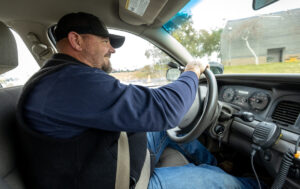
Compliance Inspector Chad Oliver takes his turn practicing in the skid pan.
“We’re all linemen, so we know there’s a lot of [potential] dangers and challenges that arise with energized work. But we also put a lot of miles on the road,” Oliver said, underscoring why the EVOC training is just as important as other types of safety trainings. “I think there’s going to be a lot that people take what they learn from this class and actually input it into their personal lives.”
Oliver emphasized that he appreciates how hard IBEW 1245 works to keep its members safe, not just through trainings like EVOC, but also through a wide range of safety-related policies that have been implemented over decades of bargaining as a result of the union holding the company to the highest possible safety standard.
“Without the union, none of this works,” he said, referring to the increase in EVOC trainings and other programs. “We’re where we are with safety because of our union fighting for us.”
Photos by John Storey